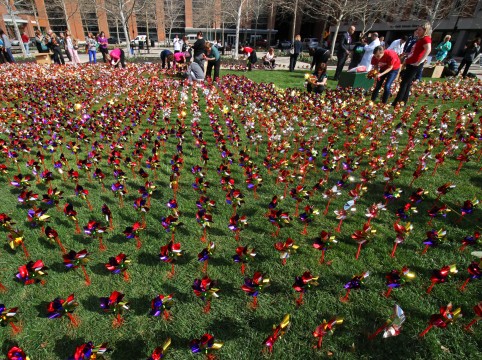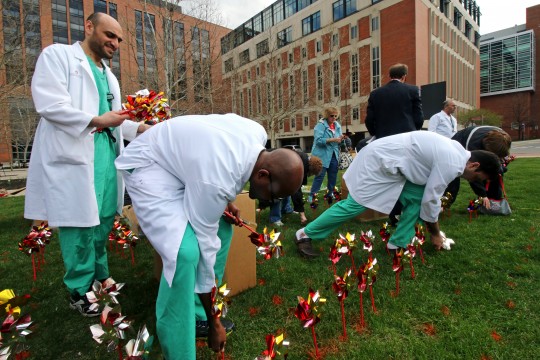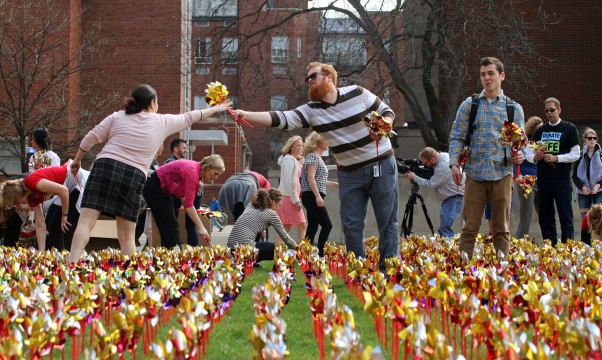Kate Enright, a second-year in marketing, was in her freshman year of high school when she received a meniscus donation.
“It has completely changed my life,” Enright said. “I couldn’t run.
“Now I can.”
Enright was one of about 100 volunteers who planted this year’s “pinwheel garden” in front of the Wexner Medical Center on Monday morning, consisting of 7,900 pinwheels, one for each organ transplant performed at OSU since 1967, according to a press release.
The pinwheels will be on display through the end of April in celebration of Donate Life Month, the release said.
Additionally, a new flag will be raised every time an organ is donated at the medical center, publicly acknowledging life-saving decisions made by patients.
Approximately 123,000 Americans are currently waiting for “life-saving or life-enhancing organ transplants,” said Robert Higgins, executive director of the medical center’s comprehensive transplant center.
“This includes kidney, liver, heart, lung, pancreas … and any combination of those organs together,” he said. “The comprehensive transplant center serves a role of coordinating all transplant related activities at the Ohio State Medical Center.”
The center works “across disciplines, across departments, across professional alignments. It’s a multidisciplinary program with well over 150 people who contribute to this success,” Higgins added.
The Wexner Medical Center also conducts research to “improve not only how we take care of those patients but how we identify organs and make them suitable for transplantation,” Higgins said.
Besides her studies, Enright is part of Buckeyes for Life, a student organization that tries to raise awareness for organ donation.
Most of the members of the organization have a personal relationship to organ donation, said Rachel Hoser, a third-year in psychology and president of the organization. Both Hoser and Enright attended Monday’s event and helped plant the pinwheel garden.
The pinwheel garden project was started seven years ago as a “visual way to express the magnitude” of organ transplants at the OSU Medical Center, Higgins said during a speech at the event.
The more surgeries and transplant operations a medical center performs, the better it becomes, Dr. Sheldon Retchin, CEO of the Wexner Medical Center, said in a speech.
“One of the key elements of surgery and transplant medicine is volume,” Retchin said, adding that the Wexner Medical Center was “one of the highest-volume transplant centers in the U.S.”
The center partners with Lifeline of Ohio, an independent, nonprofit organization which “promotes and coordinates the donation of human organs and tissue for transplantation,” according to the its website.
Lifeline of Ohio is one of 58 organ procurement organizations in the U.S., and one of five in Ohio, according to the U.S. Department of Health and Human Services’ website.
“It’s a fantastic partnership,” Higgins said of Lifeline of Ohio. “It really is extending the gift of life. It’s a great synergy.”
Kent Holloway, CEO of Lifeline of Ohio, Higgins, Retchin and Morgan Mersy, a liver transplant recipient who shared her story during the ceremony, planted the first pinwheels. Doctors, nurses and medical center staff, as well as other volunteers, followed to plant all of the 7,900 pinwheels in less than an hour.
During the ceremony, a new flag was also raised. Each of the eight spokes of the flag represents “the power one person has to save up to eight lives through organ donation,” according to a press release.
In his speech, Higgins said “the need for registered organ donors is stronger than ever.”
Holloway agreed, and said the ceremonial flag is a way to publicly honor those who have donated.
“It’s a very public message that somebody generously gave the gift of life,” Holloway said.









